The 2018 Apple iPad Pro (11-Inch) Review: Doubling Down On Performance
by Brett Howse & Andrei Frumusanu on December 4, 2018 10:00 AM ESTThe Liquid Retina Display
Apple offers some of the best displays on the market, and the iPad Pro is arguably their best display available. What Apple calls a Liquid Retina display is a 264 pixel-per-inch masterpiece. The 11-inch model we are reviewing holds a 2388x1668 7:5 aspect ratio panel, while the larger 12.9-inch model uses a 4:3 2732x2048 panel.
There’s a lot that sets Apple apart from other manufacturers on the market. The company has taken display accuracy seriously longer than anyone outside of the professional field. The display in the iPad Pro is also a P3 D65 gamut display, but thanks to the color management system that Apple moved over from the Mac, it simultaneous offers near-perfect sRGB reproduction as well as near-perfect P3 reproduction whenever an app or image specifically says it's P3. There’s no compromise on offering the P3, and no need to change the gamut on the display to match different color spaces. It’s a P3 display where sRGB is properly mapped.
In addition, Apple’s iPad Pro offers their ProMotion technology, which means it is a 120 Hz display, but one that supports variable refresh rates in order to lower the display's refresh rate for power management purposes. The iPad Pro will go as low as 24 Hz, presumably chosen to match the framerate of most movies. Apple also carries over its True Tone functionality, where ambient light sensors change the white point of the display to make it more suited to the environment it is in. It’s one of those features you never really knew you needed until you see it in action.
The fully laminated display also offers Apple’s industry leading antireflective coating, which Apple rates at 1.8% reflectivity, improving the results outdoors dramatically over most devices, and of course there is a fingerprint-resistant oleophobic coating as well.
Apple rates the latest iPads at up to 600 nits of brightness too, so pretty much no matter where you are, the combination of the high brightness and the antireflective coating should make for a great viewing experience.
To test the display characteristics, we turn to SpectraCal’s CalMAN software suite, along with an X-Rite i1Display Pro colorimeter for brightness and contrast readings, and the X-Rite i1Pro 2 spectrophotometer for color accuracy readings.
Brightness and Contrast
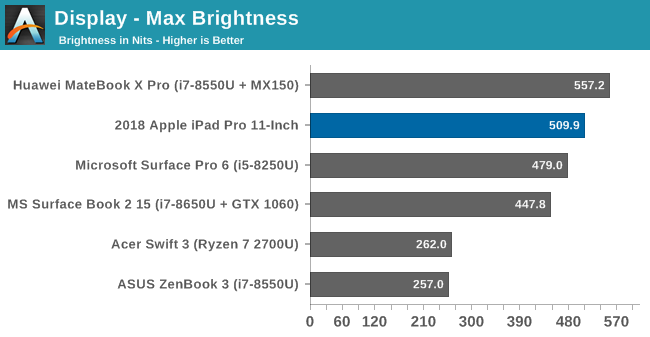
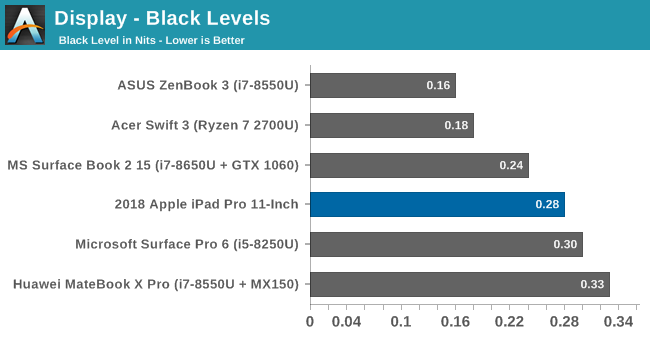
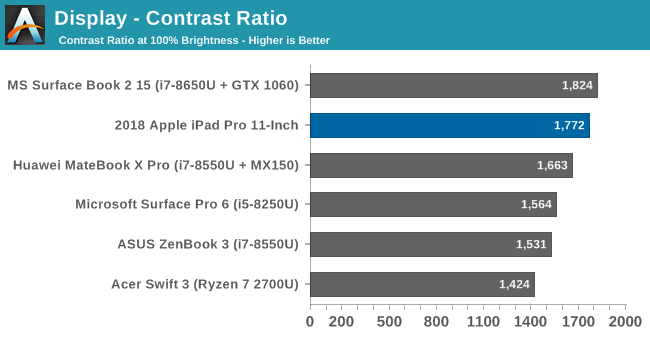
Under our test conditions the iPad Pro could not quite hit the 600 nits that Apple advertises, but at 500 nits it is still plenty bright. Couple that with the excellent contrast ratio of almost 1800:1, and things are off to a good start.
Grayscale
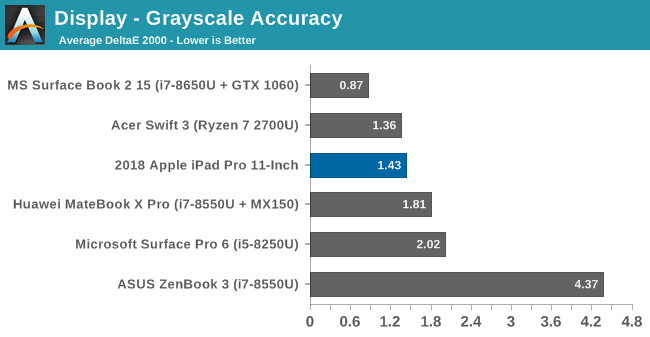
The average dE2000 of 1.43 is a fantastic result, but the gamma isn’t quite perfect, dropping off near 100% because the display was slightly too bright. Unfortunately, the red results were quite low throughout the entire range leading to a slightly cooler display white point, but this is all quite minor.
Gamut
First let’s take a look at sRGB:

As you can see, the sRGB values are almost perfectly mapped into the P3 D65 gamut, and the average error level of just over 1.09 is simply fantastic. All of the primary and secondary values are close to perfect, except red which was a bit low at 100% red, as we saw in the grayscale results.
Next up, P3 D65:
As with the sRGB results, the P3 D65 gamut is also almost perfect. The beauty of color management means that there’s no work for the user to get the benefit of both P3 and sRGB.
Saturation

The saturation sweep was run in sRGB, and as you can see from the graphs, all along all of the primary and secondary colors the error level is basically imperceptible to the human eye.
Gretag Macbeth
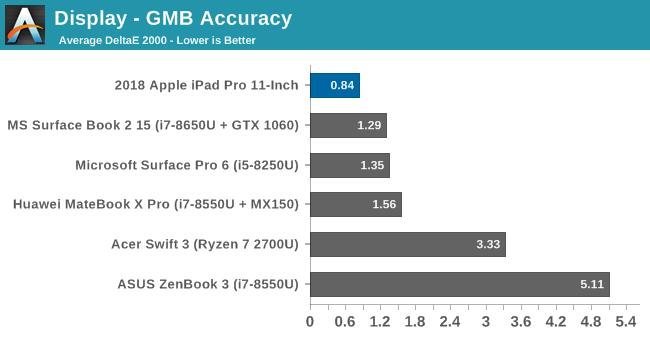
Finally, the Gretag Macbeth test is a more comprehensive test, hitting colors outside of the primary and secondary colors, including the important skin tones. The error level is practically perfect, with no single color even hitting an error level of 2.0.
Display Conclusion
The iPad Pro simply offers one of the best displays on any electronic device. Color accuracy is superb, in both the P3 and sRGB gamuts, and thanks to iOS supporting full color management, customers don’t have to worry about if they are working on a P3 or sRGB image. The addition of True Tone makes for an incredibly pleasing white point in pretty much any situation, and the 120 Hz display refresh rate makes for smooth scrolling, while stepping down to lower refresh rates to conserve power when the display is static.


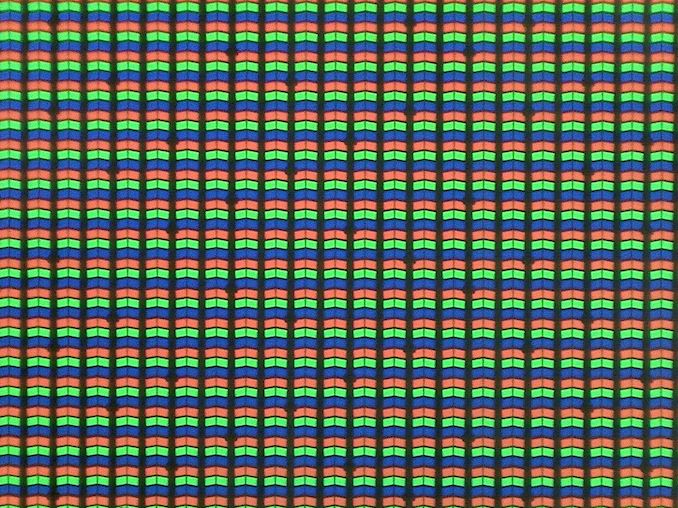


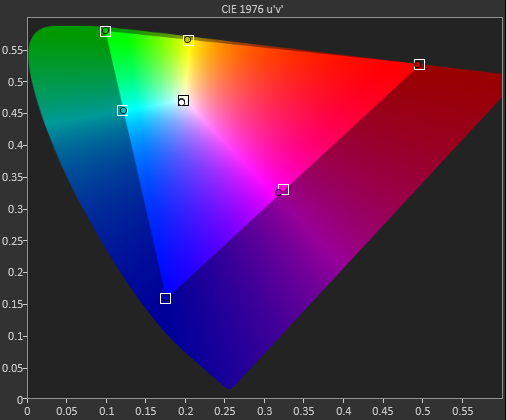










145 Comments
View All Comments
melgross - Tuesday, December 4, 2018 - link
Eh, OLEDs don’t do it either. Last year I went to an audio trade show I go to every year, and Sony was demo’ing among other things, two large TVs. One was an OLED, and the other and LCD. Both were expensive at $9,000.I asked the engineer which he would recommend for HDR and he said the LCD. The truth is that OLEDs simply don’t get bright enough. Black levels aren’t as important.
Spunjji - Wednesday, December 5, 2018 - link
I'm not sure that's entirely accurate, except for from a strict ""adherence to specifications" view. In reality, past a certain level of brightness, a TV with better contrast will look superior in an environment with controlled lighting than a brighter display that has visibly worse contrast.mlambert890 - Wednesday, December 5, 2018 - link
These reviews all seem to ignore that the iPad Pro 10.5 ever existed.This is weird because for all the talk of “this is the iPad Apple always wanted to make!” its largely the iPad they made last year, but for a fair bit more money and with more marketing hype.
Sure the CPU/GPU is even faster than the A10X, and there is now ML acceleration, but hardware hasn’t mattered on the iPad since the Air 2. There is literally nothing that runs poorly on the 10.5 at all. It even has the same 120hz “Liquid Retina” screen. Unless you are in the tiny niche of people who edit 4K video *on the iPad* (or pretend to need to), there is really no benefit from the extra CPU power.
The “revolutionary design” looks exactly the same to 99.9% of people. Especially once in a case. And in exchange for this design, you get .5” of screen, but lose the home button, fingerprint reader and headphone jack. You also lose accessory compatibility in both directions. So there is real drawback there.
For someone wanting to jump on an iPad Pro now, the new one obviously makes sense. But this is always true. Pretending that this latest iPad is more than just iterative is really disingenuous, yet every single article is treating it like we’ve gone from Air 2 -> Pro 11”
markiz - Wednesday, December 5, 2018 - link
I don't get it why do you think it's so hard to compare performance between OSes and devices?Who cares what are the absolute scores for the SoC itself, what matters is real life performance.
Is there no such benchmark, that would measure some common (or less common) scenarios, like:
- take a camera where you have some video
- transfer it to a pc
- do whatever editing you need to do
Or, like, loading and scrolling through 100 most popular webpages?
Paying your bills in online banking?
Buying a thing on amazon?
The Garden Variety - Wednesday, December 5, 2018 - link
Well thank goodness you so clearly defined the methodologies—"do whatever editing you need to do"—so it should be a totally clear and reproducible set of results within your comparison. Oh wait. What are we measuring using your system, again? Time? Against what scale? What if one task requires a different set of procedures on one operating systems than the other, which is your baseline?I don't mean to be a complete prick, but I don't think I'm too far out of bounds here to call your entire message one of the stupidest fucking things I've read yet today. But the day is young, so you've got that going for you.
sonny73n - Wednesday, December 5, 2018 - link
Many fanboys here are praising A12x which is faster than A11 but considering the price of the iPad, is it faster than the mobile Ryzen 5 or the Core i5? And for an additional 936GB of storage, you have to pay $750 more. I thought 1TB of NAND flash cost about $130 now. What a ripoff! This is straight up robbery and I refuse to be the victim.WasHopingForAnHonestReview - Wednesday, December 5, 2018 - link
Comments are filled with paid social media posters. This thing is absolutely overpriced and you STILL dant do everything you want on it. (Ios)Oyeve - Wednesday, December 5, 2018 - link
At the end of the day it's still an ipad. ios is so limited. Why doesnt apple just make a MBP in an ipad sized format?blackcrayon - Wednesday, December 5, 2018 - link
With an A12X chip? I think they're working on that.With intel chips, you're basically asking for a 12" Macbook - iPad sized, but hampered by what intel is able to give us in that form factor.
Also at the end of the day a MBP is just a MacBook Pro, so I'd still prefer they offer what the iPad can do as a separate product for now.
isthisavailable - Wednesday, December 5, 2018 - link
Please compare this to the Core M series fanless chips from intel. Apple is probably already ahead of core M.